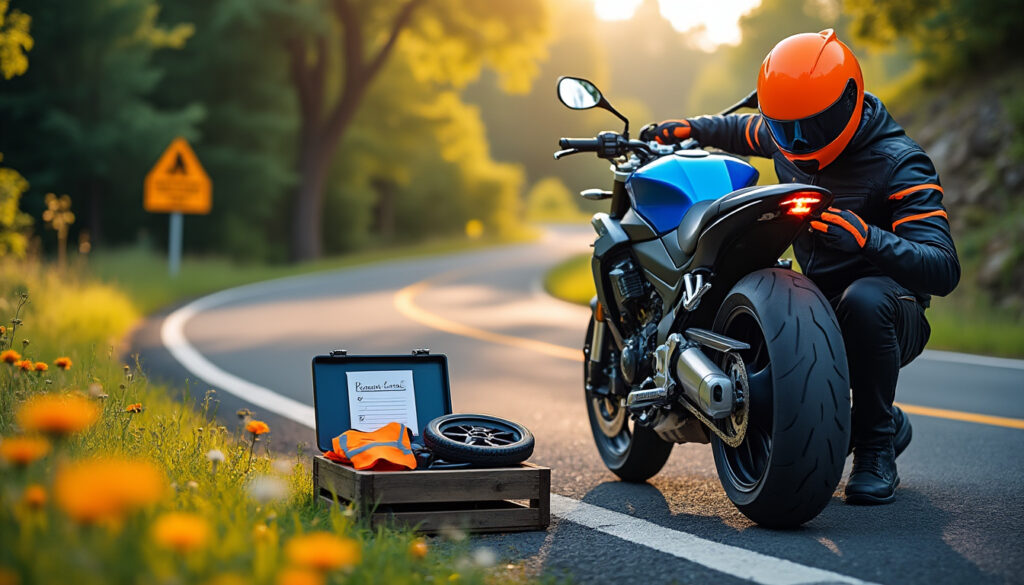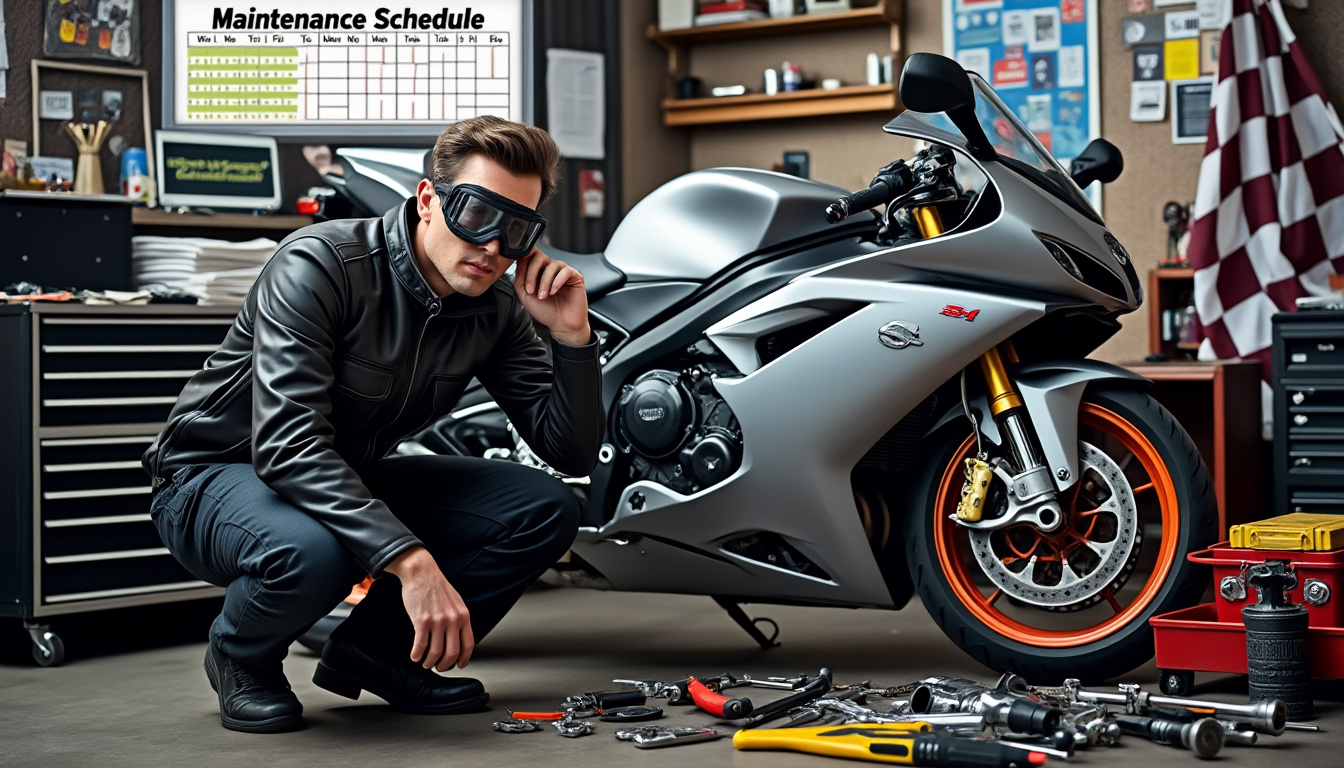Before hitting the road on a motorcycle, don’t forget the essential checks to ensure your safety

Motorcycle safety does not rely solely on the skill of the rider, but also on the overall condition of the machine and the adherence to a number of safety rules. In this year 2025, with the strengthened implementation of safety standards, it is essential to prepare well for your road trip. Here is a comprehensive guide to the checks and preparations to undertake before hitting the road on your two-wheeler.
Mechanical checks: ensuring the motorcycle's operation
Before going for a ride, special attention must be paid to the mechanical condition of your motorcycle. Make sure to check the following elements:
- Brakes: check the wear on the brake pads and the level of brake fluid. Effective braking is crucial for your safety.
- Tires: examine the pressure and wear. Tires in good condition ensure optimal grip on the road.
- Lights: make sure all turn signals, headlights, and taillights are functioning correctly to be visible to other users.
- Oil level: a well-lubricated engine operates better and is less prone to breakdowns.
- Chain and drive shaft: check the tension of the chain and its lubrication, or the condition of the drive shaft. Proper transmission ensures optimal performance.
For a more in-depth check, it is advisable to refer to the user manual of your motorcycle. Good maintenance not only increases safety but also extends the lifespan of your machine.
| Element to check | Normal condition | Action if condition is abnormal |
|---|---|---|
| Brakes | Fluid pressure between min and max | Change pads and bleed the system |
| Tires | Pressure within the recommended range | Inflate or replace if necessary |
| Lights | Normal operation | Replace blown bulbs |
| Oil level | Between min and max markers | Add oil or plan a change |
| Chain/Drive Shaft | Good tension and lubricated | Adjust tension or lubricate as needed |
In 2024, the annual technical inspection for two-wheelers became mandatory, thus reinforcing the necessity of these checks. It is essential not to neglect these mechanical aspects to avoid any incidents on the road.

Biker equipment: a guarantee of safety
Having a motorcycle in good condition is essential, but it is not enough without the right equipment. As a rider, you must be properly equipped to maximize your safety. Here is a list of equipment not to forget:
- Helmet: a quality helmet, such as those offered by brands AGV, Shoei, or Arai, is indispensable. Ensure that it is approved and in good condition.
- Gloves: choose suitable gloves that offer a good grip and optimal protection for your hands.
- Protective clothing: opt for a jacket and pants made of leather or reinforced textile, such as those by Dainese or Alpinestars. These garments should also have protections for elbows, shoulders, and knees.
- Footwear: wear high boots to protect your ankles and provide good grip on the footrests.
- Reflective accessories: visibility is key, so adding reflective elements to your gear is highly recommended.
Wearing proper equipment should never be taken lightly. Studies show that motorcyclists wearing full gear are 37% less likely to suffer serious injuries in the event of an accident.
Route planning: avoiding the unexpected
Before starting your adventure, it is crucial to carefully plan your route. This does not only concern the destination but also the intermediate stops. Here are some tips for effective planning:
- Choose your roads: some roads provide better conditions for motorcycles than others. Avoid poorly maintained roads and prefer those known for their beauty and safety.
- Anticipate weather conditions: check the forecasts before leaving and be prepared to face bad weather. Rainy weather and slippery road surfaces can increase the risk of accidents.
- Plan breaks: schedule regular stops to rest both your body and mind. This improves concentration and reduces fatigue.
- Inform your loved ones: do not forget to share your itinerary with friends or family for their safety and peace of mind.
Good preparation can make all the difference. A famous anecdote illustrates this: a group of motorcyclists who never planned often faced unexpected events, even realizing they had camped in a protected area, risking a fine!
| Element | To check | Consequence if forgotten |
|---|---|---|
| Selected roads | Geographical information and durability | Accident risks due to poor conditions |
| Weather | Local forecasts | Discomfort and danger while riding |
| Planned breaks | Time intervals and safe areas | Buildup of fatigue, reduced attention |
| Communications | Sharing travel information | Peace of mind for loved ones, safety |
Meticulous planning of your route ensures not only a more enjoyable journey but also enhanced safety on the road.

Road safety rules: a responsible behavior
Once you are on the road, it is imperative to respect certain rules that ensure your safety and that of other users. Here is a list of basic rules to follow:
- Respect speed limits: this may seem obvious, but adhering to speed limits significantly reduces the risk of accidents.
- Anticipate the movements of other users: stay vigilant and anticipate the movements of vehicles around you, particularly cars that may change lanes.
- Establish a safe following distance: always maintain a sufficient distance between you and the vehicle in front to avoid sudden braking.
- Have a preventive driving approach: always be ready to react in an emergency situation, whether it be braking or swerving.
- Do not get distracted: avoid manipulating your phone or other distractions while riding.
Road safety is a shared responsibility. By following these rules, you contribute to creating a safer traffic environment for everyone.
Road safety initiatives: evolving to prevent accidents
Motorcycle accidents remain an issue to be addressed. Various initiatives have been introduced to reduce their incidence and improve the safety of motorcyclists on the road. Here are a few examples:
- Driver training: training programs are in place to teach new riders the basics of safe riding.
- Awareness campaigns: campaigns like those by the Federation of Angry Bikers raise public awareness about the dangers faced by motorcyclists.
- Safety technologies: new devices are being introduced, such as ABS systems on motorcycles, which help prevent skidding.
- Technical inspections: the implementation of technical inspections for motorcycles, effective since 2024, provides a significant boost to road safety.
With these collective efforts, motorcycle safety is gradually improving. As a motorcyclist, it is crucial to participate in these initiatives by following the rules and staying informed regularly.
| Initiative | Objective | Expected results |
|---|---|---|
| Training | Educate new riders | Reduction of accidents among young motorcyclists |
| Awareness campaigns | Raise public awareness of dangers | Better understanding of safety rules |
| Technology | Improve the mechanical safety of motorcycles | Fewer accidents due to mechanical failures |
| Technical inspections | Check the condition of motorcycles | Ensure the safety of vehicles on the road |
Properly preparing, equipping appropriately, wisely planning your itinerary, respecting safety rules, and engaging in initiatives promoting road safety are all key elements in ensuring a rewarding and safe riding experience.
Source: actu.orange.fr
Leave a Reply



Articles relatifs